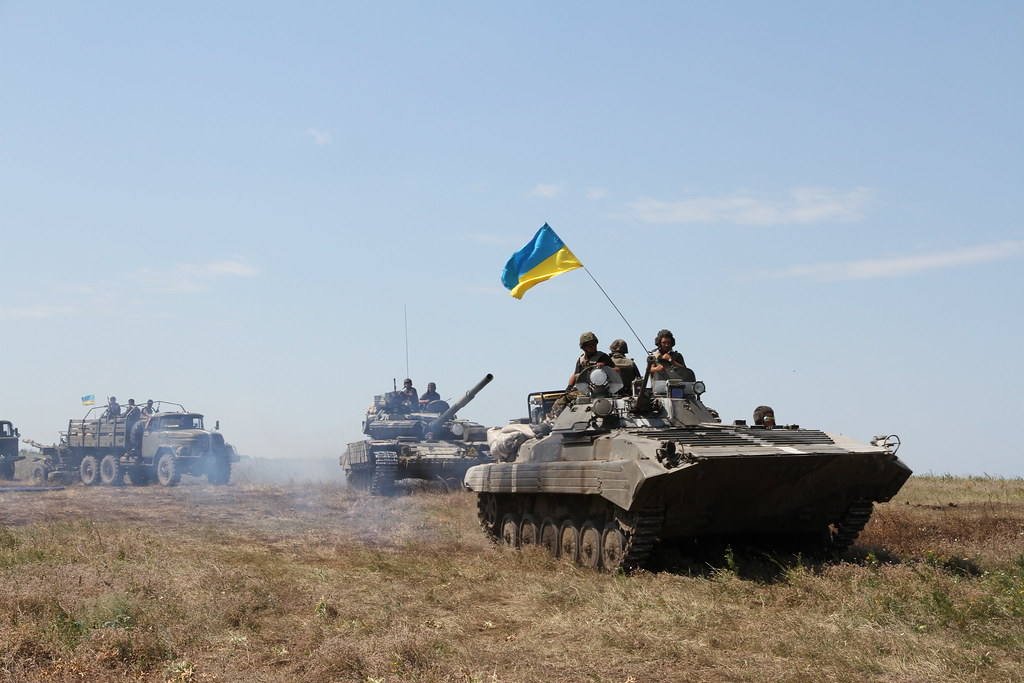While Russia and the United States are in high tension over the imminence of a Russian invasion of Ukraine, the prevention of Russian aggression rests on two pillars on which the West can weigh: diplomacy and deterrence. The West’s prospects in altering Russian calculations are contingent upon the overcoming of its divisions and speak in unison. The very high level of coordination among allies in their responses to Russia is evidence of this imperative. The watchword is clear: unity.
Yet, while there is unity in the condemnation of Russian revisionism, differences are discernible among the allies due to domestic political considerations, as well as varying degrees of exposure to the Russian threat and the consequences of a robust response to Russian aggression. Indeed, despite strong solidarity, disparities remain on four critical issues: support for Ukraine’s membership in the Atlantic Alliance, material support for Ukraine, deployment of military contingents on NATO’s eastern front, and support for sanctions against Russia. These fault lines are likely to be further exposed in the event of significant concessions to Russia or robust retaliation for Russian aggression.
Support for Ukraine’s Membership in NATO
The transatlantic community has reiterated its full support for the protection of Ukraine’s territorial integrity and for the open-door policy enshrined in Article 10 of the Alliance’s founding document. The European Union rejects the idea of a new Yalta, pitting the blocs of influence against each other, and proposes instead a new Helsinki, guaranteeing sovereignty and inviolability of borders. Russia’s demands for a buffer zone between itself and the Alliance and for Ukraine’s neutrality were therefore deemed unacceptable by Washington, NATO and the EU.
However, the promise of Ukraine’s membership in NATO offered at the 2008 Bucharest Summit has left several Western states perplexed. Officially, Russia’s demand that NATO’s eastern enlargement be halted, in line with the Kremlin’s red line, has been brushed aside by the Alliance’s members. Nevertheless, in practice, there are contrasting diplomatic approaches to the issue.
The strongest diplomatic support for Ukraine’s membership in NATO comes from Poland and the Baltic states. The latter are ready to support an accelerated integration of Ukraine into the Alliance, which they see as an additional security guarantee against Russia. Romania also supports Ukraine’s Euro-Atlantic aspirations, as does Canada, which strongly supports Ukraine’s candidacy.
Washington is taking a more cautious approach. President Biden insists that Moscow will not be able to stifle Ukraine’s desire to join the Alliance. However, Ukraine’s membership is not a priority for his administration, which instead wants to focus its energy on the Indo-Pacific. In addition to not wanting to exacerbate Russian animosity, Washington believes that Ukraine is far from a NATO eligibility, especially with regards to corruption. Similarly, London supports, through a declaration of support, Ukraine’s aspirations to join NATO. However, this support is conditional on the implementation of several political, economic and defence reforms.
Ukraine’s accession to NATO is not on the agenda either for the Minister of Foreign Affairs José Manuel Albares, in line with the position of Spain, which had opposed NATO’s roadmap for quick membership to Ukraine in 2008. As for Italy, its economic interests and heavy dependence on Russian gas (46%) represent an important counterweight to Rome’s active support for the Ukrainian candidacy. While Italy supports Ukraine’s membership in the EU, it remains evasive when it comes to NATO.
Both Paris and Berlin also opposed Ukraine’s integration into NATO in 2008, and they are currently negotiating with Kiev and Moscow in the Normandy format, which tends to limit their diplomatic support for further discussion with Russia. President Macron openly questions whether the ambiguity surrounding Ukraine’s possible membership “is not to our disadvantage.” Similarly, the German Foreign Minister considers Ukraine’s entry into the Alliance as unrealistic, while the German Chancellor considers that the issue is not on the agenda.
More forcefully, Hungary, through its Minister of Defence, has officially opposed Ukraine’s membership in the Alliance. Despite the seriousness of the Ukrainian crisis, Viktor Orban seems to favour maintaining his relationship with Moscow. Hungary is not alone in its camp. Croatia is also opposed to Ukraine’s NATO membership.
Ukraine seems to be considering some concessions to avoid war. This could include the possibility of giving up the application for NATO membership, which is enshrined in its constitution. “Maybe the question of open doors is for us like a dream,” said the Ukrainian president.
On this crucial issue in Moscow’s eyes, a strong consensus among the allies remains on the principle of the open-door policy, but divisions persist over whether Kiev should join the Alliance in the short to medium term.
Material Support to Ukraine
A second aspect of Western support for Ukraine is material. Since the West fears war, strengthening Ukraine’s military capabilities could dissuade Russia from taking action. However, here too are differences over the nature and extent of the support offered.
The United States, Ukraine’s largest donor, is providing significant support to Kiev, despite its refusal, for the time being, to deploy offensive ground-based missile delivery systems on Ukrainian territory. Two American shipments of 80 tons and 200 pounds of lethal weaponry have been delivered. This assistance is part of a broader U.S. strategy to strengthen Ukraine’s defence capabilities to mitigate the Russian military advantage. The U.S. approved the transfer of $650 million in weapons to Ukraine, the highest amount in a single year since international assistance began in 2014.
With U.S. support, the Baltic states have accelerated the flow of U.S.-made weapons to Ukraine. Lithuania and Latvia are offering Stinger anti-aircraft missiles, while Estonia will provide Javelin anti-tank missile systems. The Czech Republic will provide Ukraine with dozens of artillery shells and related equipment worth $1.7 million. Warsaw, which directly fears for its security with troop movements on the Belarusian border, also made the decision to provide defensive ammunition as well as anti-aircraft missiles and light mortars. Denmark has also announced $25 million in aid to help modernize the Ukrainian armed forces.
The United Kingdom has pledged to provide light weapons and anti-tank defence systems. According to London, these short-range weapons will increase the Ukrainian army’s capacity for self-defence in the event of an invasion. Anti-ship weaponry should also be sent to Ukraine to help the country confront Russia in the Black Sea and Azov. Finally, special forces are training the Ukrainian armed forces, particularly in the use of equipment.
France considers that direct support and greater investment would diminish its chances of playing a central role in de-escalating the conflict. However, arms contracts for the delivery of 20 patrol boats to Ukraine will be honored by the French company Ocea. Romania has not mentioned sending arms to Ukraine, but an agreement to boost military-technical cooperation with Kiev was recently signed. The same is true for Ankara. However, the Turkish government’s proposal to become a mediator in the conflict is undermined by the sale of drones, which greatly increases Ukraine’s military capabilities. Bayraktar drones are one of the most sophisticated weapons of the Ukrainian forces.
Other countries are content with non-lethal military support. Germany, for example, has offered 5,000 helmets for Ukrainian soldiers, judging that arms deliveries would not contribute to defusing the crisis. With this in mind, Berlin went so far as to block the shipment of German-made weapons from Estonia. Similarly, Canada initially limited its support to non-lethal military equipment such as body armour. After much consideration, it committed to providing $7.8 million worth of small weapons as well. Ottawa also agreed to deploy dozens of additional troops to increase the training of the Ukrainian military. The Canadian troops, who were to remain in western Ukraine, where the “risks are lowest,” were withdrawn, however, along with American and British troops, in anticipation of an imminent attack by Russia.
The allies thus differ on the nature and extent of their support for Ukraine. Maximalists have offered lethal military equipment, while the more cautious have provided non-lethal support, and many others have not taken position on the transfer of weapons.
Military Deployments
In response to the deteriorating European security environment, some Alliance members are moving to increase their military presence in countries bordering Ukraine. While the United States has ruled out an increased military deployment to Ukraine in the event of a Russian invasion, it has instead decided to deploy about 3,000 troops to Poland and Romania. These troops are in addition to the 8,500 U.S. military personnel on stand-by.
Similarly, the United Kingdom has announced the deployment of a 350-strong contingent to Poland, in addition to the 100 troops already there, while the HMS Prince of Wales, leading a maritime rapid response detachment, is still on alert. Denmark has also deployed a frigate to the Baltic Sea and four fighter aircraft to Lithuania. The Netherlands will send two F-35 fighter jets to Bulgaria as part of NATO’s air policing missions in the Black Sea region.
The French Minister of the Armed Forces, Florence Parly, was in Bucharest to recall the possibility of a deployment of several hundred French soldiers to reinforce NATO’s deterrent posture in Romania, while proposing the French candidacy to be the executive state of this force to be deployed. Germany, which had initially refused to send troops to Eastern Europe, eventually decided to provide a contingent of 350 troops to reinforce the 500 already there in Lithuania, in addition to the sale of Howitzer artillery systems. Despite a political struggle over the state’s role in NATO’s capability building, the Spanish government chose to send six Eurofighter aircrafts and a frigate with 220 troops to the Black Sea and Bulgaria to support NATO’s deterrence effort.
Canada, which commands one of NATO’s four multinational battle groups aimed at reassuring allies and deterring Russia, continues to ponder increasing its military presence in Latvia. Similarly, Italy has not contributed to NATO’s military build-up on its eastern flank, but has gone even further, saying Europe lacks the military capability to deter Russia. Both countries could therefore be called upon to contribute further to the Alliance’s capabilities in Eastern Europe.
While NATO is increasing its troops on its eastern flank, this is contested within some of the countries involved. Hungary opposes the deployment of NATO troops on its territory. According to its defence minister, Hungary does “not agree with the Cold War rhetoric that is being used, the threats and the show of force,” and does “not require the deployment of additional NATO forces” on its soil. Bulgaria and Slovakia are more equivocal. The Bulgarian defence minister was rebuffed by his prime minister after declaring his opposition to the redeployment of NATO troops to Bulgaria. Slovakia’s foreign minister, for his part, thinks it unlikely that parliament would support the deployment of a 1,000-strong NATO contingent on its territory. These misgivings undermine the consensus within NATO on the possibility of “positioning additional battle groups in the southeast of Alliance territory.”
Sanctions Against Russia
Virtually all Western countries are promising tough sanctions against Russia if it invades Ukraine. However, while the U.S. and the U.K. can impose sanctions against Russia unilaterally, the 27 EU member states must agree on common sanctions. The divergent interests of member states could complicate the development of a common sanction regime.
Neither the EU, the U.K. nor the U.S. has unveiled a sanctions regime to date, despite Ukraine’s request for one. The U.S. Senate is considering a set of sanctions that vary in intensity and could theoretically target the assets of individuals close to the Kremlin, exports of certain technologies to Russia, Russian financial institutions, the Russian extractive sector, external financing of Russian debt, the Nord Stream 2 (NS2) gas pipeline or the banning of Russia from the SWIFT banking system.
While Germany opposed the latter option, Berlin has nevertheless moved on NS2 without being clear on the subject. The German Foreign Minister said that Germany was prepared to suffer serious economic costs if Russia were to attack Ukraine. Chancellor Olaf Scholz said that Germany would remain “absolutely united” with its partners to take appropriate sanctions, without naming NS2. The U.S. President has openly stated that the pipeline would never be opened in the event of a Russian invasion.
In addition to the German ambiguity, the French government stated that “sanctions are not the alpha and omega of the response” and “must not lead to aftershocks that would have a boomerang cost for us.” A sanctions regime that is intended to be effective will necessarily be economically painful for the old continent and potentially destabilizing for the global economy because of the size of the Russian economy.
Austria opposes the inclusion of NS2 in the EU’s sanctions regime against Moscow in retaliation for an invasion of Ukraine. Hungary has also stated that further sanctions on Russia would fail and that Russian security demands are reasonable. In addition, there have been recent discussions between President Putin and Italian businessmen, despite a request by the Italian Prime Minister and parliamentarians to cancel the meeting. This reflects the difficulty that economic interests represent for the implementation of a tough sanction regime. We should also expect a Russian retaliation in case of heavy sanctions, probably in a hybrid way: instrumentalization of migrants, cyber-attacks, blackmail with gas, etc.
Therefore, despite promises of severe and coordinated sanctions in the event of Russian aggression, the costs to Europe’s economy or energy stability (40% of its gas imports come from Russia) are likely to complicate the establishment of a common sanction regime. Several allies, including Germany, “need constant coaxing.”
Moreover, the required threshold of Russian aggression that could lead to the adoption of the “mother of all sanctions” remains to be defined. While a full-scale invasion of Ukraine would undoubtedly federate a strong Western response, what about a hybrid attack? Would it be enough to impose drastic sanctions? Moreover, robust measures that could hurt Russian authorities, such as preventing the acquisition of property in the West and banning Russian funding of Western political parties, are not being considered.
Conclusion
The Atlantic Alliance and the European Union are united in the face of possible Russian aggression. However, a fault line divides allies based on domestic politics and whether they fear the use of Russian force or sanctions against Russia. The first camp includes Poland, the Baltic States and, to a lesser extent, the United States and the United Kingdom, which favour maximalist policies: they support Ukraine’s membership in the Alliance, provide lethal weapons to Ukraine, favour increased military deployments, and support the imposition of severe sanctions in the event of a Russian invasion.
A second camp brings together ambivalent allies who combine maximalist positions on some issues and more timid ones on others. France proposes a significant military deployment in Romania but remains hesitant on other issues. Canada strongly supports Ukraine’s membership in NATO but is reluctant to make a significant military contribution. Germany remains cautious on all issues, although it seems increasingly willing to abandon NS2 in the event of a Russian invasion.
A third group of allies comprise the troublemakers. While Italy is wavering on all issues, it is Hungary that is taking the most critical stance. It opposes Ukraine’s membership in NATO and sanctions against Russia and does not offer any military support to Ukraine. Worse, it intends to increase its cooperation with Russia.
Nonetheless, the minority of allies who remain skeptical about the desirability of a firm response to Russia may be under strong pressure to join the majority. This is particularly true of NATO’s troop build-up on its eastern flank, where a Russian invasion of Ukraine would amplify Euro-Atlantic solidarity. Greater divergence is likely to occur on economic and financial sanctions, due to differential cost exposure, and on military support for Ukraine, which unlike other areas, is not subject to transatlantic coordination.
At the moment, the most divisive issue remains to be Ukraine’s (theoretical) membership in NATO. Seen by some as the keystone of a peaceful way out of the crisis, the offer of a neutral status for Ukraine is seen by others as a call for further Russian aggression. The strong reactions to the “Finlandization” of Ukraine show the sensitivity of the subject in the Euro-Atlantic community. However, a Russian invasion and occupation of Ukraine would render this issue obsolete. It would signal that only NATO membership is a guarantee of security. In other words, Russia can hope to extract more from the West by maintaining its threat to invade without acting on it. Once the war begins, the allies will see that deterrence has failed and will coalesce on a punitive posture, centred on sanctions and a stronger military presence on Russia’s borders. Despite their varying intensity, these retaliatory measures will be accompanied by an outpouring of solidarity like that which followed the annexation of Crimea in 2014.







Comments are closed.